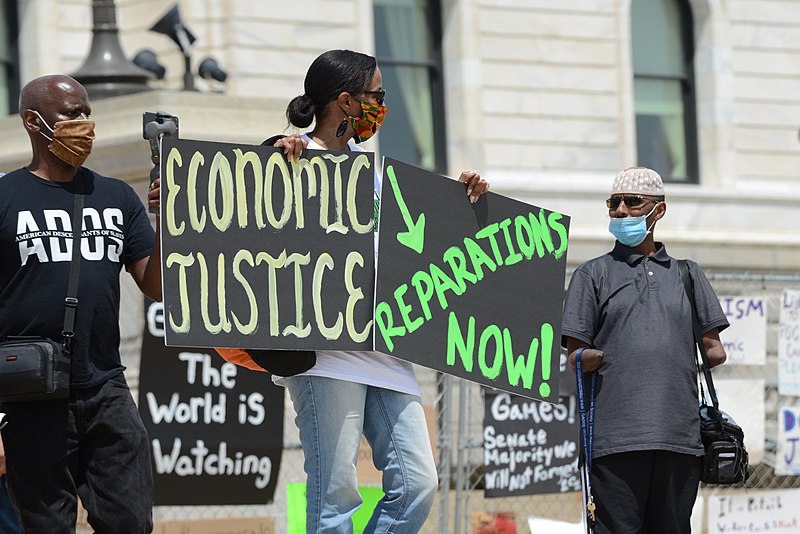
In the dis-United States today, far too many of its people have now lost all sense of proportion and as movie magnate Richard Rowland said over a century ago . . .“the lunatics have taken over the asylum.” What was formally accepted as standard American history and sociology are now being replaced with the 1619 Project and Critical Race Theory. Over all of this madness looms the specter of an institution that met its timely demise between 1865 and 1870 with the ratification of the Thirteenth, Fourteenth and Fifteenth Amendments. While the body of slavery has long since been buried, there are those today who would dig up the moldering corpse in the hope of holding it for ransom.
What turned out to be the Reconstruction era’s false promise to freed slaves of forty acres and a mule has now evolved into the current lure to their descendants of gargantuan monetary payments in the form of reparations. The idea of such cash reparations in relation to slavery is, of course, not new, with the first such payment being made in 1783. That year, a woman who had been set free after a half century of servitude in the colony of Massachusetts petitioned the then state of Massachusetts for an annual pension and was awarded a sum of what would today be about $2,500 a year. Eighty years later, after the 1863 draft riots in New York City had killed upwards of several hundred black residents and destroyed many of their homes and businesses, the merchants of that city were required to pay what would now amount to over $800,000 to care for the injured blacks and bury their dead, as well as the restoration of their property.
Today, however, the demands for reparations in the form of direct cash payments to black families who claim to be the descendants American slaves is astronomically higher. William Darity, a professor of economics and African American history at Duke University in North Carolina and a proponent of such reparations, has estimated the cost at approximately $800,000 per family and a total price tag for the American tax payers and industries of somewhere between ten and twelve trillion dollars. Others, such as Professor Thomas Craemer of the University of Connecticut who has made numerous surveys on public policy, say that the total cost would probably be closer to nineteen trillion dollars. Such a staggering amount would represent almost the present gross domestic product of the United States and nearly three-quarters of its current national debt.
The matter of reparation payments had long been merely a subject for debate and oratory, as well as the dream of many black activists, but the concept finally progressed into the legislative stage in 1989. That year, Democrat Congressman John Conyers of Michigan introduced the first of a long series of reparations measures in the House of Representatives between the years 1997 to 2007. In 2007, Conyers then offered a revised bill that would only create a commission to study and develop reparation proposals in conjunction with an African-American Act. The bill, H. R. 40, never moved any further than the Judiciary Committee that year and met the same fate each time in was reintroduced from 2009 to 2015.
Then, In 2019, a Texas congresswoman, Democrat Sheila Jackson Lee, reintroduced the measure and did so again this January. This April, the bill was finally approved by the Judiciary Committee on a strict party vote and sent to the floor for a full vote. How it will fare in the House is still uncertain but it will undoubtedly face a much harder fight in the equally divided Senate. Beyond that, it will require the president’s signature to become law. In regard to that though, after the bill was reintroduced this January, the White House issued a statement saying that “President Biden supports studying whether reparations to the descendants of enslaved people is an appropriate remedy.”
The actual text of the proposed legislation is little more than a repetition of what is being pushed by the current “woke” generation in regard to the systemic racism they claim is still rampant in America, particularly in what they charge is the still Jim Crow-minded South. The bill purports in part to, “. . . address the fundamental injustice, cruelty, brutality, and inhumanity of slavery in the United States and the 13 American colonies between 1619 and 1865 and to establish a commission to study and consider a national apology and proposal for reparations for the institution of slavery, its subsequent de jure and de facto racial and economic discrimination against African-Americans, and the impact of these forces on living African-Americans . . .”
Today’s mass hysteria about past slavery and its aftereffects has even become a matter of recent debate for the United Nations. At a General Assembly meeting in New York this September, members from African and Caribbean countries prompted the passage of a resolution which said in part that there should be a way for the descendants of slavery to seek . . . “just and adequate reparation or satisfaction for any damage suffered.”
At the same meeting, however, the U. N. Human Rights Council went even further. In a separate statement issued by the Council, Syed Mohamad Hasrin Aidid of Malaysia said, “While reparations could not compensate or right all the wrongs that had been done against the people of African descent, they could go a long way in addressing systemic racism that still lingers in the society today, in bringing about a level playing field to realize their true potential.” It is interesting to note that among the fifteen members currently heading the forty-seven member Human Rights Council are such blatant human rights abusers as China, Russia, Gabon, Uzbekistan and Cuba . . . what one might call a case of the wolves guarding the sheep.
Getting back to the question of reparations in the United States, while the South was not specifically mentioned in the House measure, the states of the former Confederacy are always the primary targets for such charges of racism as those leveled in the proposed legislation. However, the actual history of slavery, racial discrimination and segregation tells a far different story. Even the term “Jim Crow” itself, which today is synonymous with segregation in the South during the century from the end of the Reconstruction period to the passage of the Civil Rights Act, did not originate in the South. The term actually was first used in regard to an 1841 Massachusetts law mandating that train lines provide separate cars for black passengers and were dubbed “Jim Crow cars.”
There has also been a complete distortion of the entire history of racial segregation and anti-miscegenation laws in America from the colonial period to well into the Twentieth Century. This is particularly true for the years from 1876 to 1964, but a look at the actual record reveals that during that period thirty-six states enacted such laws, of which only fourteen were in the South and the other twenty-two in the North. Included in the latter group where such centers of pre-war Northern abolitionist sentiment as Massachusetts, Connecticut, Ohio and Kansas. A number of the Northern states had, prior to the War Between the States, also enacted the infamous Black Codes, many of which were more severe than those that came later.
Federal and state courts also upheld segregation and anti-miscegenation laws for many years. In Massachusetts, the issue of school segregation first became a court matter in 1849 when a black girl attempted to attend a white school nearer her home. An action to end school segregation entirely was initiated by the girl’s father, a Boston printer, and was argued before the state’s Supreme Court by future Radical Republican senator Charles Sumner. The Massachusetts court ruled, however, that school segregation was not only legal, but that integration would only increase racial prejudice.
In the face of the constitutional amendments to abolish slavery, grant citizenship to black Americans and allow them to vote, as well as a number of congressional acts to enforce those amendments, the U. S. Supreme Court also issued a number of decisions up until the last century that upheld many of the state segregation laws in both the North and South. One of these was the 1896 matter of Plessy v. Ferguson that involved railroad segregation in Louisiana. In that case, a man of mixed descent had purchased a ticket for a seat in an all-white car but had been ejected on the grounds that he was black. The high court ruled, however, that separate but equal facilities such as railroad cars were constitutional, thereby setting a precedent that later guided a number of cases in other states involving the segregation of public facilities.
In the matter of de jure school segregation, prior to the Supreme Court’s 1969 decision in the case of Brown v. Board of Education which ruled that all such segregation laws were unconstitutional, sixteen states outside the South still retained some form of legal school separation. The same ratio also held true generally in regard to anti-miscegenation laws that were not legally ended throughout America until the 1967 Supreme Court decision in the matter of Loving v. Virginia.
Housing discrimination concerning all minorities, but blacks in particular, was a far more complex situation. While most of the actual laws outside those in the South in regard to private housing had been repealed by the start of the Twentieth Century, multiple forms of de facto segregation still existed throughout the country. These included contract regulations, unethical real estate practices and mortgage rating systems known as “redlining” that were even used by federal agencies as late as the 1950s. Most of these forms of discrimination were brought to an end with the passage of the Fair Housing Act in 1968.
All of this, of course, illustrates the fact that slavery and discrimination had been facts of life throughout America for almost three centuries, as well as major chapters in the nation’s history. To deny this is to deny history itself. It is just as wrong though to conceptualize, or even erase, certain events in history to meet one’s preconceived ideas of how those events should have taken place based of today’s social praxes.
On the other hand, It is certainly most proper to acknowledge the fact that some forms prejudice, be they racial, ethnic or religious, still exist in America to some degree. To deny this is to deny human nature itself. It is, however, patently insane to legislate any compensative measure that would literally bankrupt the nation in order to redress a wrong that ended over a hundred and fifty years ago and was allowed under the Constitution up until that time.







I am for the the South the leave the U. S. A. And have our on .
Good.
What is shamefully overlooked is the dollar amount funded by our tax dollars and handed out by the US Government over the last fifty five years in the form of social welfare programs; not counting Medicare and Medicade. Over $30 Trillion and remain ongoing. These programs were championed by Presidents John Kennedy and Lyndon Johnson as the Civil Rights Act and the Great Society. Both of which have never achieved their goal or purpose.
This proposed reparations are merely a cover for the creation of more wealth for the already super rich billionaires who will gain access to the counterfeit monies as they flow to the “victim class” and then wash through the “victim class” as they spendthrift those monies away , with the aforementioned super rich investing in real wealth in land and other assets, likely in foreign countries. Meanwhile, we hapless deplorables will lose what little wealth we might have in the inflation tsunami which will inexorably follow. Thus, the power elites who most assuredly hate the “victim class” as well as us deplorables will get wealthier, obscenely so, and impoverish into annihilation those of us who are their enemies. The remnant of the “victim class” and us deplorables will then be, literally, at one another’s throats as we struggle for the last crumbs. Lucifer could not have devised a better plan!!!
Brown v. Board of Ed was 1954, not 1969.
In my humble opinion, reparations will never pass for the same reason 40 acres and a mule never happened. Northerners are too greedy, and they would never allow such a massive transfer of wealth to the South. Even today over 1/2 of the black population still lives in former Confederate states and adjacent red states.